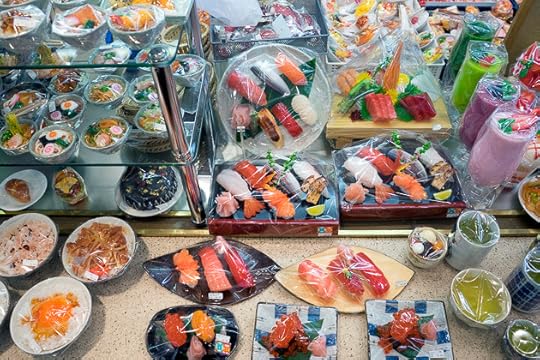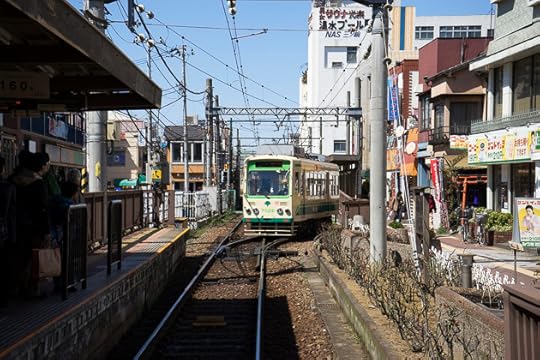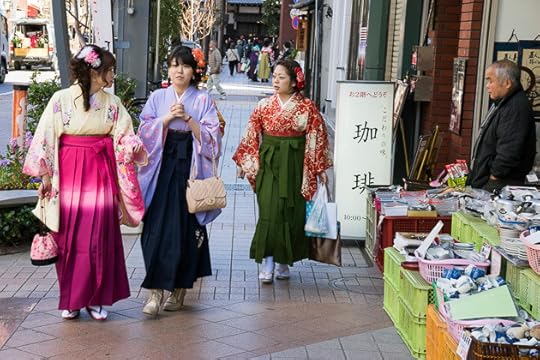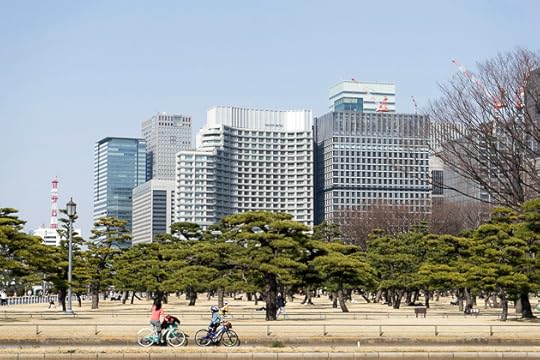Michael Powell's Blog, page 87
April 21, 2014
The Meiji Shrine
Directly across from one of Tokyo’s craziest areas (Harajuku and the Takedeshita Shopping Street) is one of the most serene. Built to guard the spirits of Emperor Meiji and the Empress Consort Shōken, the Meiji Shrine is tucked away in a large evergreen forest, where neither the city’s noise nor its stress can reach.

Emperor Meiji is largely responsible for bringing Japan into the modern age. After wresting power from the Tokugawa Shogunate and re-establishing the empire in 1868, he instituted...
April 17, 2014
The Plastic Foods of Kappabashi
Perched atop the Niimi Building, the giant head of an Italian chef welcomes visitors to Kappabashi-dōri, a street whose shops sell everything needed to run the restaurants of Tokyo: chopsticks, cups, bowls, knives, takeaway containers and, naturally, an infinite variety of plastic foods.

We love plastic food. When deciding between restaurants, we’ll always choose the one with the most plastic food in its windows. No, it’s not some strange new diet. It’s just that, in Japan, menus tend to be wr...
April 9, 2014
Sakura, Sakura: The Cherry Blossoms of Tokyo
For a short period at the beginning of April, the word “sakura” was a prominent noun in approximately 75% of the sentences I heard. Because when Tokyo’s cherry trees bloom, there’s no talking about anything else. You’re either chatting about the blossoms, planning your picnic in the park, sitting in a rowboat on a pond ringed by cherry trees, or strolling along a path while the petals flutter to the ground around you like the sweetest, most fragrant snowfall imaginable. In any case, “sakura”...
April 6, 2014
The Arakawa Tram and the Paper Museum
The streetcars which used to crisscross Tokyo have almost entirely disappeared. But in the northern neighborhood of Minoya, we found the system’s sole survivor. The Arakawa Tram runs to Waseda via Asukayama Park, where we disembarked to visit a museum dedicated to paper.

Minowa borders the former red-light district of Yoshiwara. From the days of Edo right up into the 1950s when prostitution was officially banned in Japan, Yoshiwara was Tokyo’s most infamous neighborhoods, where both female and...
Pooped Out In Tokyo

The headquarters of Asahi Breweries sports one of Tokyo’s most puzzling bits of architecture. The building is meant to resemble an overflowing mug, with a drop of amber beer splashing down the side… but that drop looks an awful lot like something else. And so everyone knows the Asahi Beer Hall as the “Golden Poo”.
We could spend 91 days in Tokyo walking aimlessly, photographing the city’s architecture and slices of life. Enjoy this first set of random pictures, taken mostly in and around Asaku...
April 3, 2014
Asakusa Amusements
Its reputation as the entertainment center of Tokyo has long since faded, the Kabuki Theaters relocated and geishas (mostly) vanished, but the northeastern neighborhood of Asakusa still boasts a few attractions apart from the temple of Senso-ji.

From the late 19th century and up until the 1945 firebombing of WWII, Asakusa was where Tokyo came to relax. All manner of fun was on offer, from red-light types of pleasures, to more family-friendly entertainment like dancing and recitals. In 1890, th...
April 2, 2014
Sensō-ji Temple
Constructed in the year 645, Tokyo’s oldest temple is the Sensō-ji, in the neighborhood of Asakusa. Like everything else in this city plagued by earthquakes and fire, it’s been rebuilt multiple times, but the temple remains one of the city’s most historic and popular sights.

A visit to Sensō-ji begins through the Kaminari-mon, a large gate protected on either side by the Gods of Thunder and Wind. After sneaking past these formidable wooden guardians, you’ll emerge onto the Nakamise-dōri Shoppi...
March 30, 2014
The Golden Dragon Dance of Senso-Ji
The Nakamise-Dori shopping street in front of Senso-Ji, Tokyo’s oldest temple, is always crowded. But today, not a single person was paying attention to the sweets or souvenirs on offer. Instead, all eyes were cast upwards, as a 60-foot dragon wound its way above the crowd. It was March 18th and Senso-Ji was celebrating the Kinryu no Mai, or Golden Dragon Dance.

In the year 628, two brothers found an icon of the Boddhisattva Kannon, while fishing in the Sumida River. Non-believers, they threw...
March 27, 2014
Hibiya Park & The Outer Palace Gardens
For such a congested and populous city, Tokyo has a surprising amount of green space. Take, for example, the area directly outside the Imperial Palace. The Kyoko Gaien (Outer Garden) once held the houses of the provincial lords, and today offers people a spacious place to stretch out on the grass. We visited it, as well as the nearby Hibiya Park, on a sunny Sunday afternoon.

Since our arrival in early March, this was the first day warm enough to make a jacket strictly optional, and we weren’t...
March 25, 2014
Tokyo Station and Marunouchi
The sprawling Tokyo Station, at the center of the city, serves an outrageous 3000 trains a day. Simply walking through it can be a maddening struggle. Just to find the subway line which would take me home, I needed 40 minutes in Tokyo Station, three separate information stands, and an underground hike of over a kilometer. I wish it were so, but that is in no way an exaggeration.

The classic, red-brick western facade of Tokyo Station was completed in 1914 with a design by architect Tatsuno King...



